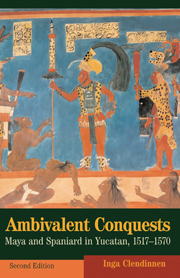Book contents
- Frontmatter
- Contents
- List of illustrations
- Preface to the second edition
- Preface to the first edition
- Acknowledgments
- Map I Yucatan in the conquest period
- Part I Spaniards
- 1 Explorers
- 2 Conquerors
- 3 Settlers
- 4 Missionaries
- 5 Conflict
- 6 Crisis
- 7 Attrition
- 8 Retrospections
- Epilogue: The hall of mirrors
- Part II Indians
- Epilogue: Confusion of tongues
- Appendix: A sampler of documents
- Glossary of Spanish and Maya terms
- Notes
- Select bibliography
- Index
4 - Missionaries
Published online by Cambridge University Press: 05 October 2013
- Frontmatter
- Contents
- List of illustrations
- Preface to the second edition
- Preface to the first edition
- Acknowledgments
- Map I Yucatan in the conquest period
- Part I Spaniards
- 1 Explorers
- 2 Conquerors
- 3 Settlers
- 4 Missionaries
- 5 Conflict
- 6 Crisis
- 7 Attrition
- 8 Retrospections
- Epilogue: The hall of mirrors
- Part II Indians
- Epilogue: Confusion of tongues
- Appendix: A sampler of documents
- Glossary of Spanish and Maya terms
- Notes
- Select bibliography
- Index
Summary
The Indians have friers in great reverence: the occasion is, that by them and by their meanes they are free and out of bondage; which was so ordeined by Charles the emperor: which is the occasion that now there is not so much gold and silver coming into Europe as there was while the Indians were slaves …
Henry Hawkes, 1572Franciscans were to dominate the missionary enterprise in Yucatan, as they had in Mexico. If to a twentieth-century mind the motives of a Bernal Díaz, for all their distinctive accenting, are sufficiently familiar to be intelligible, missionaries, and Franciscans, are less accessible. What would move a Spanish youth in the early decades of the sixteenth century to join the Franciscan order, and then to opt for service in a remote corner of a remote New World? What vision would lead him to those actions, and how might that vision be sustained or modified by experience in the field?
First, he would be choosing not the complete withdrawal from the world of the closed orders of monks, not the integration into the world of the secular priest working within the parish system, but membership of an institution designed to mediate between the elevated-spiritual, and the earthy-mundane. While friars of the mendicant orders maintained the prayerful discipline of monks, they also undertook preaching rounds to reanimate the faith of the people, and cultivated a popular touch.
- Type
- Chapter
- Information
- Ambivalent ConquestsMaya and Spaniard in Yucatan, 1517–1570, pp. 45 - 56Publisher: Cambridge University PressPrint publication year: 2003

